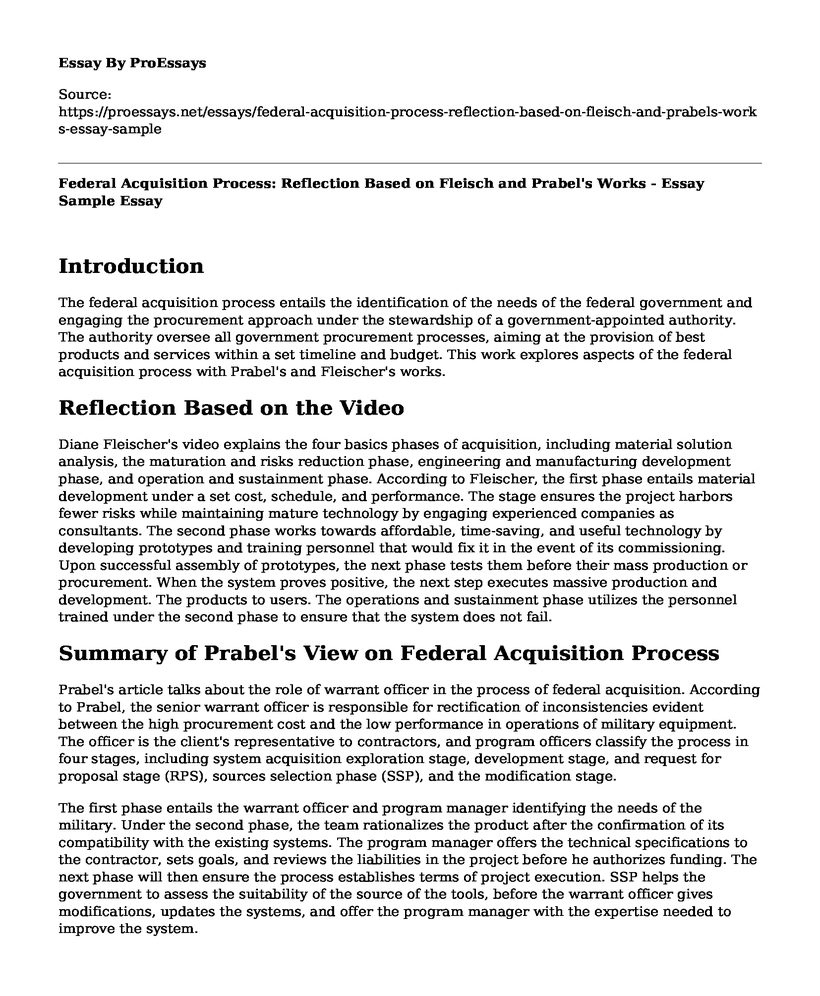Introduction
The federal acquisition process entails the identification of the needs of the federal government and engaging the procurement approach under the stewardship of a government-appointed authority. The authority oversee all government procurement processes, aiming at the provision of best products and services within a set timeline and budget. This work explores aspects of the federal acquisition process with Prabel's and Fleischer's works.
Reflection Based on the Video
Diane Fleischer's video explains the four basics phases of acquisition, including material solution analysis, the maturation and risks reduction phase, engineering and manufacturing development phase, and operation and sustainment phase. According to Fleischer, the first phase entails material development under a set cost, schedule, and performance. The stage ensures the project harbors fewer risks while maintaining mature technology by engaging experienced companies as consultants. The second phase works towards affordable, time-saving, and useful technology by developing prototypes and training personnel that would fix it in the event of its commissioning. Upon successful assembly of prototypes, the next phase tests them before their mass production or procurement. When the system proves positive, the next step executes massive production and development. The products to users. The operations and sustainment phase utilizes the personnel trained under the second phase to ensure that the system does not fail.
Summary of Prabel's View on Federal Acquisition Process
Prabel's article talks about the role of warrant officer in the process of federal acquisition. According to Prabel, the senior warrant officer is responsible for rectification of inconsistencies evident between the high procurement cost and the low performance in operations of military equipment. The officer is the client's representative to contractors, and program officers classify the process in four stages, including system acquisition exploration stage, development stage, and request for proposal stage (RPS), sources selection phase (SSP), and the modification stage.
The first phase entails the warrant officer and program manager identifying the needs of the military. Under the second phase, the team rationalizes the product after the confirmation of its compatibility with the existing systems. The program manager offers the technical specifications to the contractor, sets goals, and reviews the liabilities in the project before he authorizes funding. The next phase will then ensure the process establishes terms of project execution. SSP helps the government to assess the suitability of the source of the tools, before the warrant officer gives modifications, updates the systems, and offer the program manager with the expertise needed to improve the system.
Comparison Between Fleischer's and Prabel's Work
The two works have similarities regarding the process. They both classify the process into phases, with the basics in the stages entailing understanding the need for an organization, having the right personnel for the technical and financial needs of the project. Analysis of the works indicate a progression from one stage to another, where satisfactory execution of the proceeding phase allows moving to the next.
However, Prabel specifies his work on the role of warrant officer in the procurement process. While Fleischer talks of the client, Prabel uses warrant officers who must work under a government project manager. The two scholars indicate the weight of understanding schedules and performance of the product through research and testing prototype before contracting. The two pieces admit that the move reduces possible risks and increases public confidence in the process.
Despite the type of product an organization needs, the process of federal acquisition follow similar steps. The phases prove rigorous and need progressive advancement from one aspect to the next.o The process aims to reduce the technical risks, achieve quality products under the most favorable budget, and maintain the integrity of the acquisition process.
References
Prabel, C. F. (1986). Warrant officer in system acquisition. Army Research Development & Acquisition, 22-26. Retrieved from https://books.google.co.ke/books?id=hoEEqewyxswC&pg=PA21&dq=federal+acquisition+process+magazine&hl=en&sa=X&ved=0ahUKEwiEk8LAu4foAhULAcAKHQNIDscQ6AEIJzAA#v=onepage&q=federal%20acquisition%20process%20magazine&f=false
The Acquisition Moment: Defense Acquisition Explained with S'mores. Retrieved from https://youtu.be/PBf4pduLgzo
Cite this page
Federal Acquisition Process: Reflection Based on Fleisch and Prabel's Works - Essay Sample. (2023, Apr 20). Retrieved from https://proessays.net/essays/federal-acquisition-process-reflection-based-on-fleisch-and-prabels-works-essay-sample
If you are the original author of this essay and no longer wish to have it published on the ProEssays website, please click below to request its removal:
- Essay Sample on Deconstructing America
- The Corrupt Bargain Essay Example
- How to End the War With Japan Using the Option of "Diplomacy" Essay
- Literary Analysis Essay on Jones' Book
- Paper Example on Governance: Key to Country's Success
- Book Analysis Essay on A Brilliant Solution: Inventing the American Constitution
- Applying Nelson Mandela's Leadership Skills to My Leadership - Essay Sample







